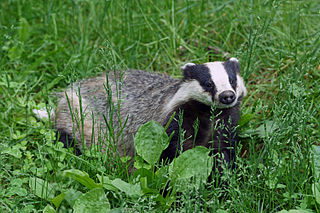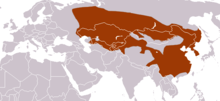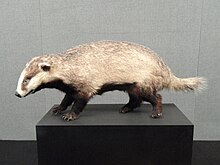
The wildcat is a species complex comprising two small wild cat species: the European wildcat and the African wildcat. The European wildcat inhabits forests in Europe, Anatolia and the Caucasus, while the African wildcat inhabits semi-arid landscapes and steppes in Africa, the Arabian Peninsula, Central Asia, into western India and western China. The wildcat species differ in fur pattern, tail, and size: the European wildcat has long fur and a bushy tail with a rounded tip; the smaller African wildcat is more faintly striped, has short sandy-gray fur and a tapering tail; the Asiatic wildcat is spotted.

Badgers are short-legged omnivores in the family Mustelidae. Badgers are a polyphyletic rather than a natural taxonomic grouping, being united by their squat bodies and adaptions for fossorial activity. All belong to the caniform suborder of carnivoran mammals.

The honey badger, also known as the ratel, is a mammal widely distributed in Africa, Southwest Asia, and the Indian subcontinent. Because of its wide range and occurrence in a variety of habitats, it is listed as Least Concern on the IUCN Red List.

The European badger, also known as the Eurasian badger, is a badger species in the family Mustelidae native to Europe and West Asia and parts of Central Asia. It is classified as least concern on the IUCN Red List, as it has a wide range and a large, stable population size which is thought to be increasing in some regions. Several subspecies are recognized, with the nominate subspecies predominating in most of Europe. In Europe, where no other badger species commonly occurs, it is generally just called the "badger".

The least weasel, little weasel, common weasel, or simply weasel is the smallest member of the genus Mustela, family Mustelidae and order Carnivora. It is native to Eurasia, North America and North Africa, and has been introduced to New Zealand, Malta, Crete, the Azores, and São Tomé. It is classified as least concern by the IUCN, due to its wide distribution and large population throughout the Northern Hemisphere.

The European mink, also known as the Russian mink and Eurasian mink, is a semiaquatic species of mustelid native to Europe.

Meles is a genus of badgers containing four living species known as Eurasian badgers, the Japanese badger, Asian badger, Caucasian badger and European badger. In an older categorization, they were seen as a single species with three subspecies. There are also several extinct members of the genus. They are members of the subfamily Melinae of the weasel family, Mustelidae.

The steppe polecat, also known as the white or masked polecat, is a species of mustelid native to Central and Eastern Europe and Central and East Asia.It is listed as Least Concern on the IUCN Red List because of its wide distribution, occurrence in a number of protected areas, and tolerance to some degree of habitat modification. It is generally of a very light yellowish colour, with dark limbs and a dark mask across the face. Compared to its relative, the European polecat, the steppe polecat is larger in size and has a more powerfully built skull.

The beech marten, also known as the stone marten, house marten or white breasted marten, is a species of marten native to much of Europe and Central Asia, though it has established a feral population in North America. It is listed as Least Concern on the IUCN Red List on account of its wide distribution, its large population, and its presence in a number of protected areas. It is superficially similar to the European pine marten, but differs from it by its smaller size and habitat preferences. While the pine marten is a forest specialist, the beech marten is a more generalist and adaptable species, occurring in a number of open and forest habitats.

The tundra wolf, also known as the Turukhan wolf, is a subspecies of grey wolf native to Eurasia's tundra and forest-tundra zones from Finland to the Kamchatka Peninsula. It was first described in 1792 by Robert Kerr, who described it as living around the Yenisei, and of having a highly valued pelt.

The greater hog badger is a very large terrestrial mustelid native to Southeast Asia. It is listed as Vulnerable in the IUCN Red List of Threatened Species because the global population is thought to be declining due to high levels of poaching.

The Siberian weasel or kolonok, is a medium-sized weasel native to Asia, where it is widely distributed and inhabits various forest habitats and open areas. It is therefore listed as Least Concern on the IUCN Red List.

The Abyssinian genet, also known as the Ethiopian genet, is a genet species native to Ethiopia, Eritrea, Somalia, Sudan, and Djibouti. It is listed as Data Deficient on the IUCN Red List. It is one of the least-known genet species.

Ferret-badgers are the six species of the genus Melogale, which is the only genus of the monotypic mustelid subfamily Helictidinae.

The yellow-throated marten is a marten species native to the Himalayas, Southeast and East Asia. Its coat is bright yellow-golden, and its head and back are distinctly darker, blending together black, white, golden-yellow and brown. It is the second-largest marten in the Old World, after the Nilgiri marten, with its tail making up more than half its body length.

Stink badgers or false badgers are the species of the genus Mydaus of the skunk family of carnivorans, the Mephitidae. They resemble the better-known members of the family Mustelidae also termed 'badgers'. There are only two extant species – the Palawan stink badger or pantot, and the Sunda stink badger or teledu. They live west of the Wallace Line; the Sunda species on islands of the Greater Sunda Islands, being Sumatra, Java, and Borneo; in Borneo the badger is found in Indonesia, Malaysia and Brunei. The Palawan species lives in the Philippine island of Palawan as well as the islands surrounding it.

The Japanese badger is a species of carnivoran of the family Mustelidae, the weasels and their kin. Endemic to Japan, it is found on Honshu, Kyushu, Shikoku, and Shōdoshima. It shares the genus Meles with its close relatives, the European and Asian badgers. In Japan, it is called by the name anaguma (穴熊) meaning "hole-bear", or mujina.

The Turkmenian fox, also known as the Persian fox, is an Asiatic subspecies of red fox distinguished by its very small size and primitive cranial features. It inhabits the Middle Asian plains and approximately south of latitude of Ustyurt Plateau and the Aral Sea, as well as contiguous parts of Iran, Afghanistan and Pakistan.

The Caucasian badger or Southwest Asian badger is a species of badger native to Western Asia and some islands in the Mediterranean Sea.























